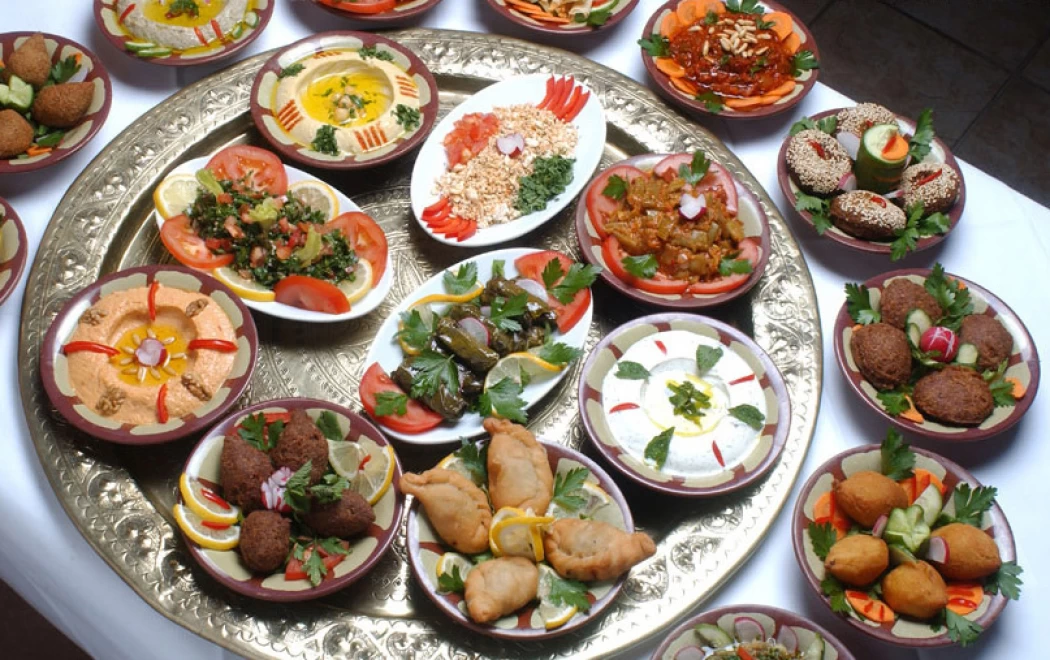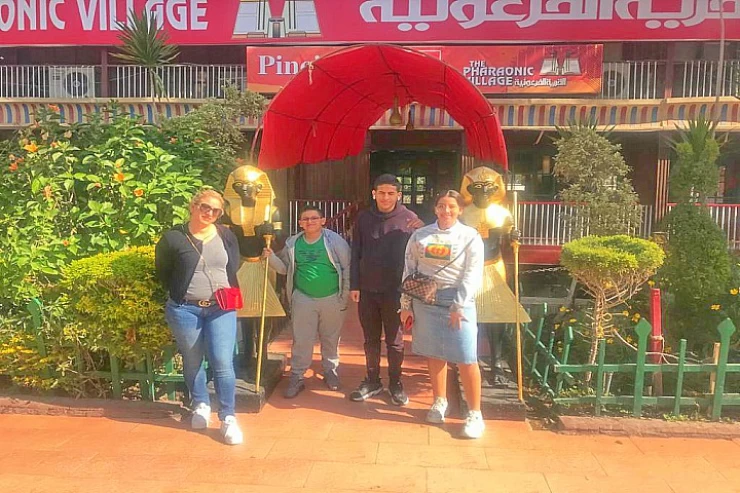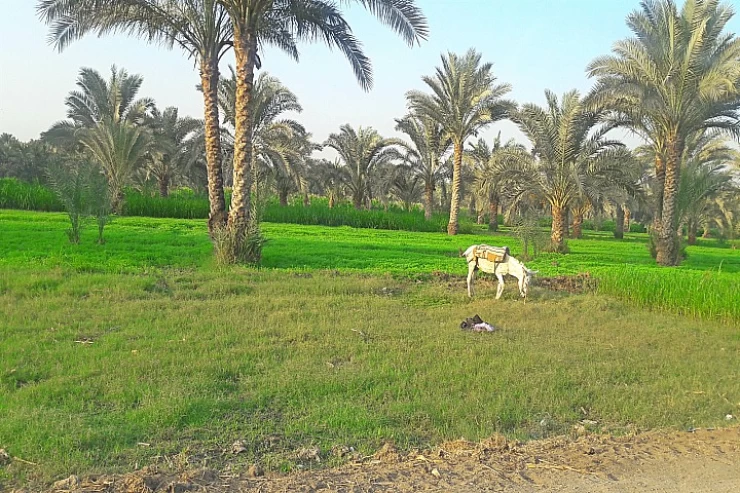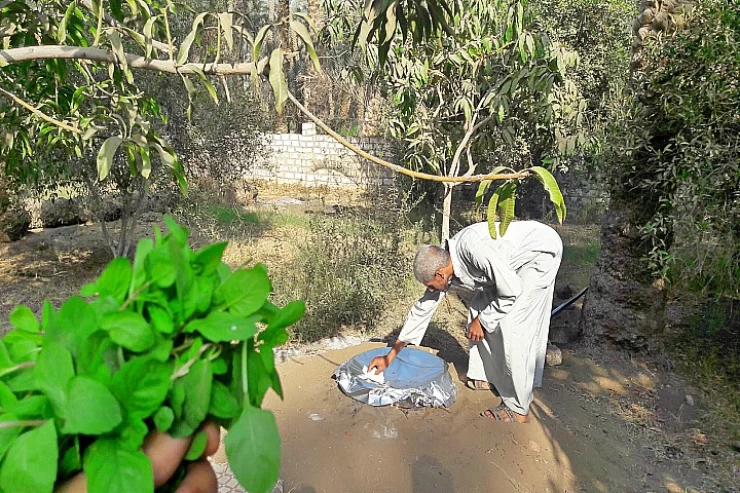
Egyptian Cuisine
Egyptian cuisine is characterized by its extensive use of legumes, vegetables, and fruits sourced from the fertile Nile Valley and Delta. It exhibits notable similarities with the culinary traditions of the Eastern Mediterranean region. Among the well-known Egyptian dishes are rice-stuffed vegetables, grape leaves, shawarma, kebab, and kofta. Notable recipes include ful medames, which consists of mashed fava beans; Kushari, a combination of lentils and pasta; and molokhia, a stew made from bush okra. Pita bread, referred to locally as eish Baladi, along with the practice of cheesemaking, has origins tracing back to the 1st Dynasty of Egypt, with feta cheese being the predominant variety consumed today. As Egypt is recognized as the first agricultural civilization in the world, its food culture emphasizes the importance of a balanced diet. Meals typically encompass proteins, vegetables, carbohydrates, vitamins, and iron, making them complete and nutritious.
Traditional Egyptian cuisine prominently features a variety of meats, including rabbits, pigeons, chicken, and ducks. Lamb and beef are typically reserved for grilling. In Cairo, falafel stands out as a popular fast food option, while dessert pies have been a staple in the region for over 2,500 years. Additionally, fish and seafood are prevalent in Egypt's coastal areas, with Alexandria being particularly renowned for its offerings. The prevalence of vegetarian dishes in Egyptian cuisine can be attributed to the relatively high cost of meat and the dietary practices of the Coptic Christian community, which often adheres to vegetarianism for most of the year.
Egyptian cuisine exhibits a strong preference for vegetarian dishes, largely due to its significant reliance on beans and plant-based ingredients. While the culinary offerings in Alexandria and other coastal cities prominently feature fish and seafood, the diversity of Egyptian cuisine varies across different governorates, with a predominant focus on agricultural products. The Egyptian Red Sea ports historically served as the primary gateway for spices from Europe, facilitating the introduction of various spices over time. These spices have significantly influenced Egyptian culinary practices, with cumin being one of the most frequently utilized. Other widely used spices include coriander, chili, black pepper, anise, bay leaves, dill, ginger, cinnamon, mint, and cloves.
Among the common meats found in Egyptian cuisine are rabbits, pigeons, poultry, and ducks. It is often boiled to make broth for various soups and soups. Lamb and beef are the most common meat used in barbecue. Grilled meats such as kofta (kofta), kebab (kebab), and grilled slices are referred to intermittently as barbecue.
It is popular in Egypt, in the guts of animals and various types of meat. The liver and sandwiches specializing in Alexandria are among the most famous fast food in the country. Minced pieces of liver fried with sweet pepper, hot pepper, garlic, cumin, and other spices are served in baguette-like bread called eish fino. It also eats cows' brains and sheep in some cities in Egypt.
The intersection of cuisine and religious observance is particularly notable during the month of Ramadan, a significant period of fasting for Muslims in Egypt. This month is characterized by extensive food preparation, especially after the daily fast is broken. Iftar, the meal that marks the end of the fast, is a communal event where families gather around the table immediately following sunset and the Maghrib prayer. A variety of dishes are served, with an emphasis on diversity and richness. Traditional desserts such as Kunafa and Qatayef are commonly enjoyed during this time. Additionally, many Egyptians set up special tables for the less fortunate, often in street tents, known as the "Table of Mercy," which reflects one of the 99 names of God. The nature of these tables can vary from simple to lavish, depending on the resources of the host. In parallel, observant Christians in Egypt follow fasting periods as outlined in the Coptic calendar, which can extend to more than two-thirds of the year for the most devout. Conversely, the more secular members of the Coptic community typically observe fasting primarily during Easter and Christmas. The Coptic fasting diet is predominantly vegan, with adherents consuming vegetables and legumes prepared in oil while abstaining from meat, poultry, and dairy products, including butter and cream.
Beverages: In Egypt, tea holds significant cultural and social importance, often serving as a customary element during family visits. The act of sharing tea can reflect the social status of the individuals involved or the intent behind the visit, making it a vital aspect of hospitality. In Egyptian culture, tea is colloquially referred to as "duty," emphasizing the obligation to serve it to guests, while other refreshments are considered supplementary. Coffee, known as Qahwa in Egyptian Arabic, is also an integral part of traditional hospitality. It is typically brewed in a small pot called Dalla and served in diminutive cups known as Fengan. The coffee is generally sweetened to varying degrees, categorized as ‘al Riha, Mazbout, and Ziyada plus Sariaose, with unsweetened coffee referred to as Sada. Sugar cane juice is a widely favored beverage available from numerous fruit juice vendors throughout Egyptian cities. During the Islamic month of Ramadan, licorice teas and carob juice drinks are traditionally consumed, alongside Amar al-din, a thick beverage made by dissolving dried apricot sheets in water, which are often enjoyed as candy. Another popular drink during Ramadan is Sobia, a sweet coconut milk beverage typically sold by street vendors. Additionally, a refreshing tamarind drink known as Tamr Hindi, which translates to "Indian Dates," is particularly sought after in the summer months. Our Egyptology expert will offer extensive insights into the history of Egypt and its historical landmarks.
Culinary Expeditions in Egyptian Food: History and Gastronomy in One Buffet
Each nation has its specialties and recipes that draw from time, culture, geography, and so on, and Egypt is not an anomaly in that order. Egyptian food culture has existed and flourished for thousands of years, and their culinary practices may constitute the simplest of natural ingredients, but they have always been rich and flavorful. Whether swirling through the street markets of Cairo, having seemed more exotic than any empire’s cuisine while dining by the Nile, or tucking into the home-cooked food of relatives in a village in Egypt, one finds the thrill of finding new and exciting combinations of flavors and cuisines in the Egyptian culinary experience, which is also home to wondrous sights.
We can begin from the very first Egyptian bread ovens installed by the Pharaohs and come to the kitchens of today. This only goes to show that Egyptian food is very traditional but at the same time takes in a lot from Italy, the Middle East, Africa, and other places. Now let’s get ready for exploration—culinary exploration to be more exact—and examine the unique features, typical cuisine, and role of eating in Egypt.
A Historical Feast: The Origins of Egyptian Cuisine
The history of food in Egypt dates back to the Pharaoh's time. This is because ancient Egyptians played a great role in agriculture, growing wheat, barley, vegetables, and fruits along the banks of the Nile, which was very fertile. The making of bread was integral to the people, and learning to bake bread is among the oldest culinary practices in Egypt. On tomb paintings and hieroglyphs, images of an intact banquet consisting of bread, fish, meat, fruits, and beer are illustrated, which indicates the significance of food in ancient Egypt.
Throughout the ages, Egypt’s culinary art has changed due to many factors over the centuries. For instance, the Greeks, the Romans, and many other civilizations including the Ottomans and Arabs had a role in these changes. Each civilization made contributions in one way or another, bringing along new herbs, cooking methods, and food elements that fused with the ethnic culture of the region to give rise to the effective and delicious cuisine that we have nowadays.
The cuisine of Egypt is characterized by the use of uncomplicated and healthy ingredients, most of which are produced in Egypt itself. Here are some of the main elements that are central to the practice of cooking in Egypt:
Fava beans (ful): Fava beans are one of the most popular ingredients in Egypt, featuring in full, another traditional dish in which fava beans are stewed, and taameya, or Egyptian falafel.
Bread (Aish Baladi): In every Egyptian meal, there is bread included. The most familiar is called aish baladi, which is a circular flatbread made from whole wheat flour slightly thicker than pita and used extensively. It is used to scoop food, wrap around food, and with many other dishes.
Rice: In Egyptian culture, rice is often served as a side dish and is usually exceptional to dishes like gumbo, grilled dishes, or loaded up with other ingredients and spices.
Lentils: The lentil pulse is popular and often used in many Egyptian plates; for example, these include soups, stews, and kosher.
Herbs and spices: One of the main reasons is that most of the food is also full of warm and earthly favors. So, fresh herbs like cilantro, parsley, dill, and spices like cumin, garlic, cinnamon, and turmeric are often added in cooking.
Molokhia: Another quintessential favorite from Egypt is molokhia, which is derived from a green leafy plant with a warm and gooey texture served as a garlicky soup and eaten with rice or bread.
Within Egypt's extensive history, there exists an array of Egyptian dishes that are quite distinct from one another. Thick hearty stews, deep-fried street snacks, and sugary desserts that provide warmth—there is something for everyone. Below are some of the primary dishes that typify the Egyptian food culture:
1. Ful Medames: The National Dish of Egypt
Ful medames, or farinaceous porridge, as it is better known, is a delicious, rich food consisting of seasoned, slow-cooked fava beans with olive oil, lemon, garlic, and cumin. Normally it is taken for breakfast with additional healthy foods such as fresh bread and eggs and some other vegetables like tomato, onion, and cucumber. Being Egyptian national food, it is highly appreciated by residents, and clearly for the tourists, it is a must-dish. This uncomplicated and delicious it has been part of culinary history for many generations, even from Pharaoh’s reign.
2. Taameya: Egyptian Falafel
Globally referred to as felafel, the taameya is the Egyptian equivalent of this popular street food. Unique to the Egyptian version of taameya is the use of fava beans instead of chickpeas to prepare also lighter, airier, and fluffier balls than the rest. Light, crispy, and deep-fried golden brown fritters flavored with herbs—coriander and parsley—would usually be sandwiched in between tahini, salad, and pickles. Taameya can be eaten as a snack or consumed as a meal, and it will prove hard to resist for anyone who tries it.
3. Koshari: The King of Street Food
The most popular street food in Egypt is kosher. Meaning “a mixture,” comfort comes naturally wherever this staple meal type exists. Koshari consists of rice, lentils, macaroni, and chickpeas, which are further topped with a delicious tangy tomato sauce as well as crunchy fried onions and spicy garlic vinegar. Due to its filling properties and inexpensive price, this carbohydrate-rich food entices every Egyptian citizen across all strata. Although kosher boasts simple and cheap ingredients, the dish is a complex jumble of flavor and texture and is highly seasoned.
4. Molokhia: A Green, Garlicky Delight
One of the first food experiences that leaves visitors to Egypt oftentimes unprepared is the strangely tasty and textured dish called Molokhia. The dish consists of cooked mookhia leaves (which are the jute leaves), blended with garlic and coriander to make an edible green paste. This dish is often served together with rice or a dish called aish baladi (Egyptian bread) and is sometimes eaten with chicken, rabbit, or beef. The slimy feel of the dish may take some getting used to, but it is a treasured dish among the Egyptians because of the comfort it brings along with the flavor of the dish, which is not normalized.
5. Mahshi: stuffed vegetables
Mahshi is a common term for toppings stuffed into vegetables such as zucchinis, peppers, or grape leaves that contain rice, spices, and sometimes meat. The stuffing is the center of having tomatoes, onions, and all the spices, which results in the rich and interesting taste of the dish. Mahshi is often cooked on holidays and parties due to the time and effort invested in cooking it. This dish consists of tender soft vegetables in every bite filled with aromatic rice, making it a perfect yummy comfort food back home in Egypt.
6. Fattah: A Festive Feast
Fatet, located in the middle of the plate, is a celebratory platter put together only on rare occasions, such as wedding parties or religious festivities. It consists of crisp, deep-fried bread pieces, rice, and stewed meat, all drenched in vinegar and garlic sauce. The way of serving and eating changes as the dish is filled with broth, resulting in a sumptuous and rich dish that fills one's stomach. In Egyptian traditions, Fattah connotes plenty and refreshment and is thus served and savored on occasions such as feasts and family get-togethers.
7. Hawawshi: Egyptian Meat Pie
Ful medames is a popular street food in Egypt made from boiled fava beans seasoned with olive oil, salt, and cumin. Hawawshi can be considered the Egyptian version of a meat pie. Ground, spiced, and cooked meat, often combined with vegetables and will almost always contain herbs, is present in a pocket of pita bread and oven-baked. The end product is a very sumptuous, tasty, and moist filling beautifully enveloped in a crisp crust. Hawawshi is well-loved by many as a street bite and is ideal for snacking in a hurry or for a quick lunch.
And no exploration of Egyptian gastronomy would be seen as if without having a taste out of its sweetest part. Egyptian sweets are heavy and rich, loaded with nuts, honey, and spices. Below are some of the famous confections found in the native country:
Basbousa: Syrup cake garnished with either almond or coconut. In Egypt, this sweet, moist cake is symbolic of festivities, and it is served in almost all functions.
Konafa: Pestilious stuffing of nuts, cream, or cheese, prohibitively sweetened and layered in a cake made of a very thin chick pastry rolled into slippery threads. In many Arabic countries, konafa is served during the holy month of Ramadan and other feasts.
Om Ali: Egyptian pudding made of layers of marinated and baked phyllo dough and milk with nuts, raisins, and spices. This rich and hearty dessert is usually prepared during festive occasions like family gatherings and cultural events.
Shai is among the beverages that are most enjoyed in various aspects of life in Egypt, more so in gatherings. It is typical for the Egyptians to consume tea without milk, sweetened with sugar, or flavored with a bit of mint. In the case of many Egyptians, tea is not just another drink but an intricate cultural aspect because it represents hospitality and relaxation, especially after a heavy meal or while engaged in social activities with friends. In addition to tea, Karkadeh, which can be referred to as hibiscus tea in English, is another beverage well appreciated in Egypt characterized by its unbelievable red color and a tasty sourness.


















